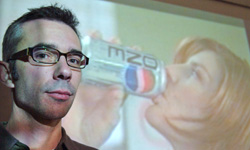Soar on the value of product placement

Communication Studies professor Matt Soar shares some screen time with Renée Russo and an ubiquitous co-star.
Photo by kate hutchinson
Communication Studies Professor Matt Soar is also interested in what you are being sold while you watch the movies.
“J & B scotch is omnipresent in Capote,” Soar said.
A Brokeback Mountain bar scene features an enormous, glowing Budweiser sign. “In fact, you’d be forgiven for thinking that only Budweiser advertises in bars, watching movies from the last few years.”
Soar says that there are over 40 different agencies whose sole purpose is to ensure that their clients’ products are conspicuous in movies, TV shows and video games. They represent a $3.5-billion industry.
Soar is in the second phase of a Social Sciences and Humanities Research Council of Canada Research/Creation in the Fine Arts grant. His project on logos, branding and product placement was one of the first to receive money through this 2003 pilot program.
Brand Hype is a website (www.brandhype.org) that tracks product placement in movies. Soar hopes to develop a dialogue about hypercommercialism and the place of corporate interests in culture. Among other things, this involves “the collapse between what you might call church and state – or advertising and editorial.
For Soar, the issue is not just the 17 instances of product placement in Spiderman II or the 80 different moments when characters are framed with, caught using, or mentioning different products in How to Lose a Guy in 10 Days.
“There is nothing accidental in a frame in a movie,” Soar said. So, when Heath Ledger’s character is in a small coffee shop in Brokeback Mountain, the camera’s pan across a huge shiny Coke machine is not happenstance. Especially when you consider that Focus Pictures produced the film for Universal, which in turn deals with Coke for promotions.
Soar’s research assistants have already entered product placement details for 100 films into the Brand Hype database. Visitors to the site can search the database by product or film, enter discussion forums and even enter their own mapping of product placement through the user-friendly database. Soar would like visitors to expand the project, as has been done with the Internet Movie Data Base and Wikipedia.
Soar said that the Screen Actors Guild and the Writers Guild of America are raising artistic concerns about pressure to rewrite scenes to include certain brands. Soar’s concerns are cultural.
Movie theatres are very absorbing environments. Even when the movie is bad, few people actually walk out: “You don’t want to destroy the experience for yourself or anyone else.” Advertisers have a captive audience, and fairly sophisticated technology to reach them.
Corporate influence on media is not new. The Oscar-nominated Good Night, and Good Luck discusses TV during the McCarthy-era ’50s. The narrative is driven by the fear that the show might lose its sponsorship by making political waves. Soar added that during that time, De Beers used to pay screenwriters to put diamonds into plotlines.
The potential for advertisers and product placement to determine the types of movies that are made was one of the themes of Behind the Screens, a documentary Soar produced in 2000.
However, that project, which can be viewed on the Brand Hype site is already dated, since its examples are several years old. Soar sees the advantage of the website because as people add to it, it continues to remain fresh.
Soar is also interested in negative product placement. In contrast to the shiny coffee shop Coke machine in Brokeback Mountain, a seedier scene in the movie features Pepsi, giving the product an unpleasant association.
Many would argue that no publicity is bad, which may be why Soar’s critical indictment of product placement in Behind the Screens holds the first spot on the American Marketing Association’s list of resources on the subject.